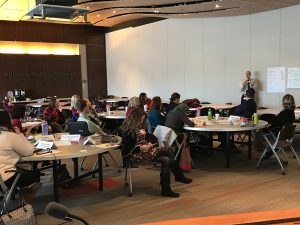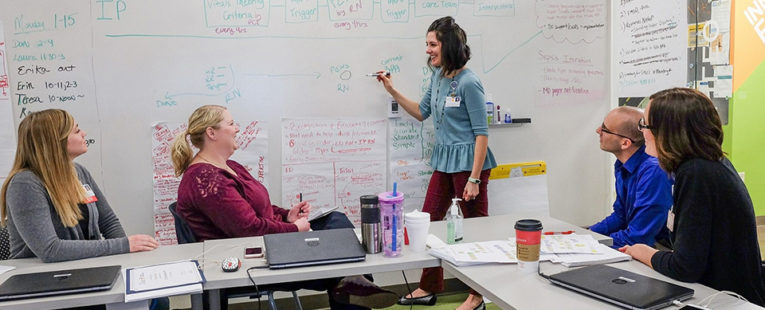As part of the Performance Improvement (PI) team, it’s our role to come up with simple solutions to improve the way care is delivered within our facilities. We’ve traditionally achieved this by gathering information from subject matter experts on projects over a period of months until we had enough data to craft new processes we could put into place. While successful, this methodology is complex and time-consuming. As part of the overall OSF Innovation umbrella, we wanted to come up with a way to speed up this process to deliver solutions in a much quicker fashion.
As a result, we formed a group that could do this type of work day in and day out called the Solution Design and Integration team. This collaborative, made up of various disciplines, includes PI, patient experience, clinical education, clinical practice, clinical integration and healthcare analytics. We also bring on ad hoc members who are well-versed in whatever issues we are trying to tackle.
The goal of this team is simple: come into work every day in a common environment and stay focused on a particular challenge for up to 20 business days, using design-thinking, innovation, PI and agile tools until a solution is developed.
How does Solution Design and Integration work?
On day one of the Solution Design and Integration team coming together on a particular project, members hold a kick-off session with subject matter experts (SMEs) to learn more about the challenge they are looking to solve. Using design-thinking tools, we brainstorm for an entire work day to come up with high-level solutions.
We then go through each of these solutions to detail out what they would look like in practice, getting feedback from SMEs along the way. A final recommendation is then presented to the SMEs, along with education and test of change plans. The solution then goes to leadership for approval.
Our first design challenge centered on scheduling patients who have suffered heart failure for a follow-up appointment within five days of being discharged from a hospital. Evidence shows that patients who visit their provider within those five days have a decreased chance of returning to the hospital because they are better equipped to manage their illness.
 The solution our team devised was to give the scheduling responsibility to a patient’s case manager who is already a part of the patient’s care team and can collaborate with him or her to find an open slot on a provider’s schedule. This is instead of leaving the role to an outside scheduler who doesn’t know the patient in question.
The solution our team devised was to give the scheduling responsibility to a patient’s case manager who is already a part of the patient’s care team and can collaborate with him or her to find an open slot on a provider’s schedule. This is instead of leaving the role to an outside scheduler who doesn’t know the patient in question.
This solution developed by the Solution Design and Integration team has been tested at two OSF HealthCare hospitals with great success, and we’ve recently received approval to add a few other facilities to this pilot program before full implementation. Completing multiple tests of change is important before rolling an initiative out Ministry wide, so improvements can be made along the way.
This team is working on coming up with solutions on at least four other issues.
Perfecting the Model
As we continue to go through each design challenge, we are having feedback sessions with the team to learn what has worked well and what needs to change. That includes adjusting our meeting schedule to ensure team members have enough time to maintain their other job responsibilities and determining how long each project design should take. We also want to ensure we are leaving enough time for our team to sufficiently train those impacted by our solutions.
Overall, we believe this way of working allows us to fail faster, succeed sooner and develop solutions that are improving care delivery and patient outcomes.
Last Updated: April 26, 2018
